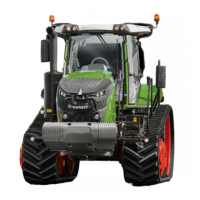
Do you have a question about the FENDT Vario MT 938 and is the answer not in the manual?
Emphasizes technician's role in safety and understanding the manual.
Instructions on how to use and understand the service manual.
Explains the meaning and importance of safety symbols.
Defines DANGER, WARNING, and CAUTION messages.
Explains the use of 'Important' and 'Note'.
Guidance on maintaining and understanding safety signs.
Covers warranty, modifications, and general precautions.
General safety rules for operating and maintenance.
Safety precautions when using pressurized air for cleaning.
States that AGCO equipment is asbestos-free.
Safety measures during electrical storms.
Safe procedures for getting on and off the machine.
Essential checks before starting the engine.
Steps for safely starting the engine.
Checks to perform before starting machine operation.
Guidelines for operating the machine.
Correct procedures for parking the machine safely.
Safety considerations for the operator's station.
Safety measures to prevent cuts and crushing injuries.
Information and warnings regarding the ROPS.
Precautions to prevent burns from hot components.
Safety information regarding hot coolant.
Safety precautions for handling hot oils.
Safety warnings related to high-pressure lines.
Dangers of fluid penetration and safe leak checking.
Safety precautions for handling batteries and acid.
Safety measures when working with exhaust fumes.
Importance of hearing protection due to noise.
Safety guidelines to prevent fires and explosions.
Information on installing and using a fire extinguisher.
Safety checks and procedures for road transport.
Explanation of the structure and meaning of serial numbers.
Guidance on selecting lubricant viscosity based on temperature.
Detailed table of lubricant types and viscosity grades.
Lists various fluids and their approximate refill capacities.
Detailed schedule of maintenance tasks based on hours.
Maintenance schedule for specific engine models.
Maintenance chart for tractors and forest machines.
Daily or 10-hour interval maintenance tasks.
Weekly or 100-hour interval maintenance tasks.
Maintenance tasks for 400-800 hour intervals.
Guidance on identifying engines with hydraulic lash adjusters.
Procedure for changing fuel filters.
Procedure for bleeding the fuel system.
Maintenance tasks for 4000-hour intervals.
Maintenance tasks for annual or 1200-hour intervals.
Maintenance tasks to be performed every two years.
Extra maintenance instructions.
Specifications for coolant quality.
Requirements for fuel quality and standards.
Specifications for tightening torques of various fasteners.
General warnings and care for fasteners.
Information on constant torque hose clamps.
Assembly torque values for metric fasteners.
Assembly torque values for inch fasteners.
